"I love connecting people back to the Earth—bringing them a tiny step closer to falling in love with our planet again and teaching them the language the Earth speaks in, which is the language of awe and wonder."
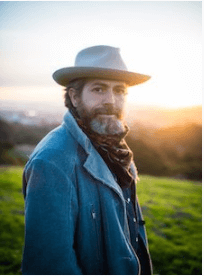
Esalen faculty, author and artist Day Schildkret believes connecting more with nature can be one of the most valuable opportunities during the COVID-19 pandemic.
Internationally known for his morning altars, a stunning array of sublime mandalas he creates daily from natural materials, as well as his of book, Morning Altars: A 7-Step Practice to Nourish Your Spirit through Nature, Art and Ritual, Day has inspired people across the globe to be awed with impermanent earth art.
“I think what’s needed from all of us right now is this sense of ‘listening’ to this much greater source—COVID-19—which is reminding us that we don’t exist at the very top, and that if we connect with nature, we strengthen our connection to the Earth.”
Day leads Earth Altars for Life Transitions: The Healing Power of Nature, Art and Ritual, August 21-23 at Esalen. He feels employing the morning altars art practice makes our lives more meaningful and helps us experience gratitude for the planet.
“I’m really contending, both with my work and my audience, that we can stop taking so much from the planet and that we can practice giving back more, especially beauty. Our relationship with the Earth needs to be reciprocal. The Earth is our host. Life loves beauty. And our Earth is alive and she loves beauty, too.”
Day shares more with Esalen News about lessons we can learn during COVID-19, his creative process and also gives us a glimpse of photos of his sublime creations.
Esalen News: How has it been for you during COVID-19?
I think the greater question is: how has this time been for all of us? It’s a wondrous thing to be in something together. My experience is really reflective of most of my family and friends’ experiences, which is up and down, broken and whole, left and right, back and forth, and occasionally we get graced with the center of those directions. When I’m not swinging back and forth then it’s this moment of grace.
What is the lesson we can learn from this time?
It’s too soon to tell. Oftentimes lessons and learning are like a stew. The real tastiness and delicacy of it come over time. During a crisis, to try to mine the lessons from it too soon almost goes against the lessons themselves. What this time is asking from all of us is to not try to take in too much right now, especially the “learning.” It’s asking us to slow down enough to perhaps have the capacity to listen again and bring us back into balance.
My suggestion during this time, which I consider to be a liminal time, is to refuse the “normal.” Stop trying to return back to “normal.” It’s very similar to what Joseph Campbell talks about with the hero’s journey, which is once you cross that threshold, it’s futile to go back. Keep moving forward. We eventually may get to this thing called normal again, but hopefully it includes bringing back gifts from this time we have now.
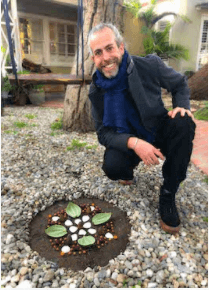
How has your creative path changed you?
I can make beautiful art, but the real lesson is that I am not separate from nature. I am making art with nature and nature is making art with me. And sometimes we cooperate and sometimes we don’t. Sometimes the wind blows it all away before I want it to. Sometimes I struggle and get upset and that’s humbling. That’s a very good place to be sometimes—to be humbled by forces bigger than us.
What lessons have you learned from creating the morning altars?
I love doing something new and modern and very old at the same time. You can go back in history and see humans collaborating with nature to make art. I love that my art lends itself to dedication and devotion and that it can be an offering to the time we find ourselves in.
That’s why I call the creations altars, because they are a dedication to this time. I love connecting people back to the Earth—bringing them a tiny step closer to falling in love with our planet again and teaching them the language the Earth speaks in, which is the language of awe and wonder. If we could, even if just for a moment during our days, leave our house and wonder at a tree or a leaf or even bark, even if it’s for one minute, we are exercising a muscle that as kids was very strong—curiosity.
As adults, that muscle can atrophy. This art really brings people to a sense of wonder and curiosity about things that are rather ordinary, like leaves and feathers, but if they are arranged in a certain way, people say, “wow” or “ah.” And that’s the language our planet is asking us to speak again. To behold the Earth.
Experience Day’s morning altars below. Stay connected with us at http://www.esalen.org/page/connection-time-social-distancing. (Photos courtesy of Day Schildkret)
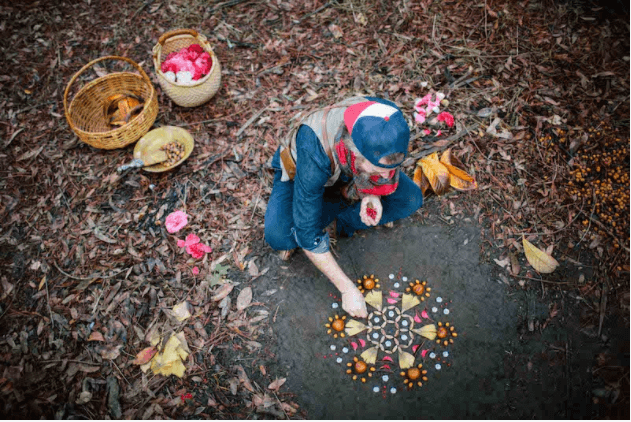
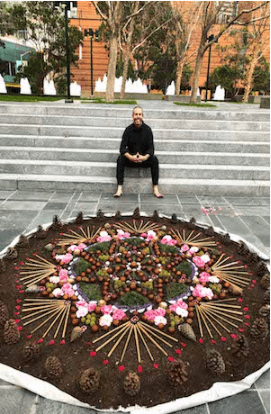
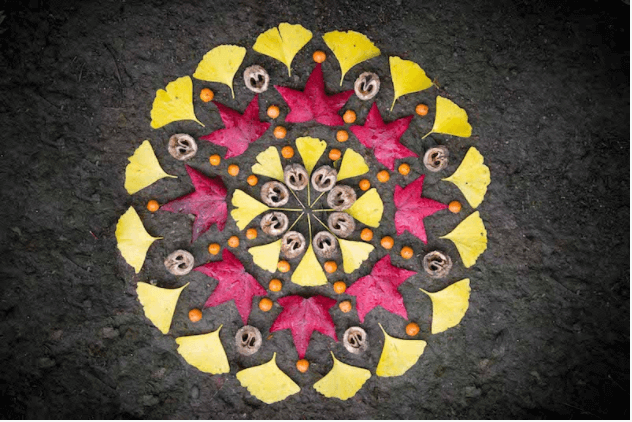
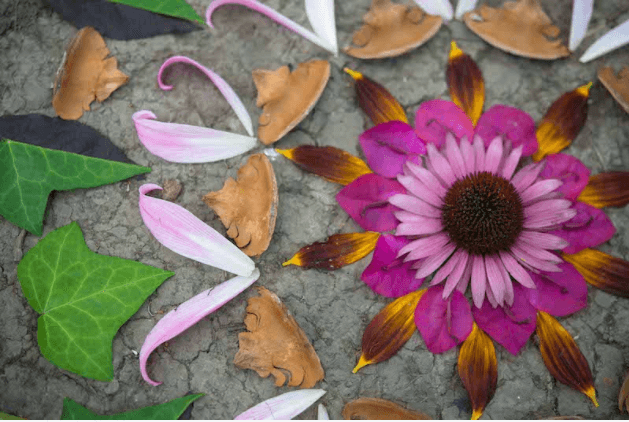
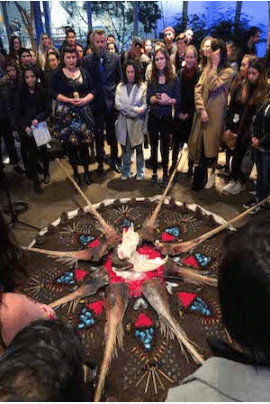
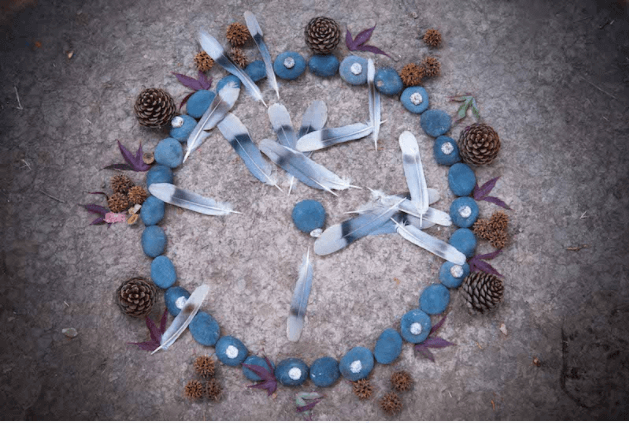
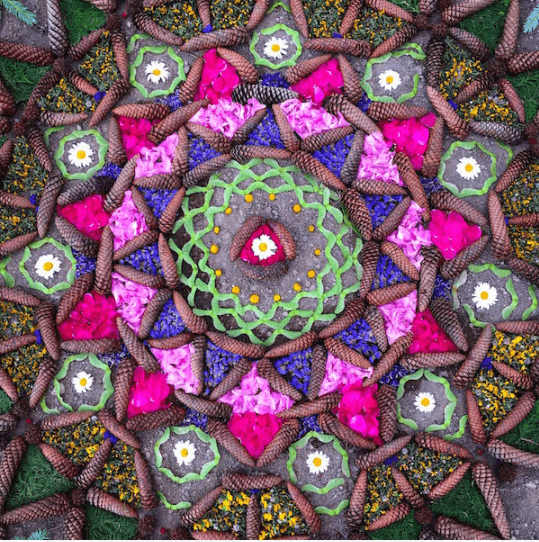
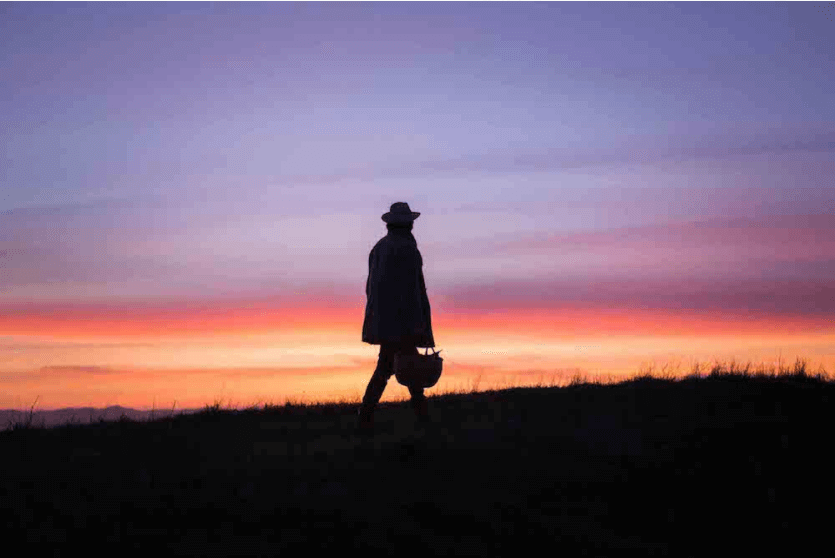

“Remembering to be as self compassionate as I can and praying to the divine that we're all a part of.”
–Aaron
“Prayer, reading, meditation, walking.”
–Karen
“Erratically — which is an ongoing stream of practice to find peace.”
–Charles
“Try on a daily basis to be kind to myself and to realize that making mistakes is a part of the human condition. Learning from our mistakes is a journey. But it starts with compassion and caring. First for oneself.”
–Steve
“Physically: aerobic exercise, volleyball, ice hockey, cycling, sailing. Emotionally: unfortunately I have to work to ‘not care’ about people or situations which may end painfully. Along the lines of ‘attachment is the source of suffering’, so best to avoid it or limit its scope. Sad though because it could also be the source of great joy. Is it worth the risk?“
–Rainer
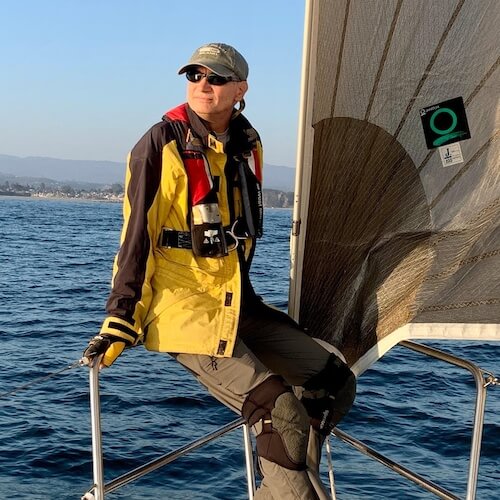

“It's time for my heart to be nurtured on one level yet contained on another. To go easy on me and to allow my feelings to be validated, not judged harshly. On the other hand, to let the heart rule with equanimity and not lead the mind and body around like a master.”
–Suzanne
“I spend time thinking of everything I am grateful for, and I try to develop my ability to express compassion for myself and others without reservation. I take time to do the things I need to do to keep myself healthy and happy. This includes taking experiential workshops, fostering relationships, and participating within groups which have a similar interest to become a more compassionate and fulfilled being.“
–Peter
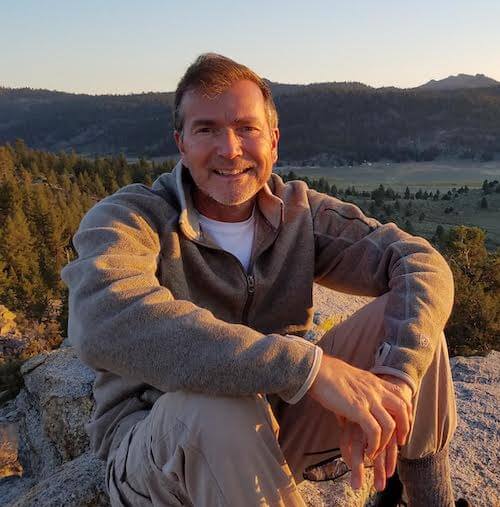
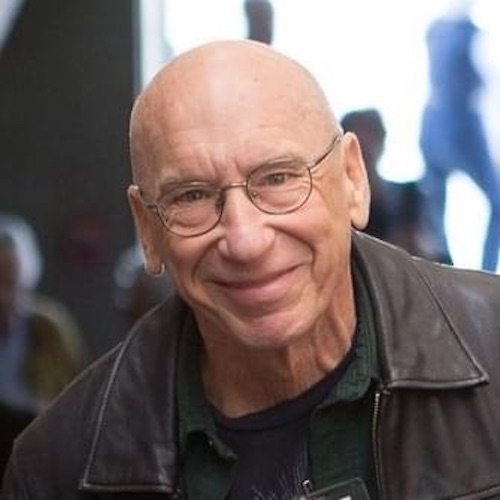
“Self-forgiveness for my own judgments. And oh yeah, coming to Esalen.”
–David B.
“Hmm, this is a tough one! I guess I take care of my heart through fostering relationships with people I feel connected to. Spending quality time with them (whether we're on the phone, through messages/letters, on Zoom, or in-person). Being there for them, listening to them, sharing what's going on with me, my struggles and my successes... like we do in the Esalen weekly Friends of Esalen Zoom sessions!”
–Lori

“I remind myself in many ways of the fact that " Love is all there is!" LOVE is the prize and this one precious life is the stage we get to learn our lessons. I get out into nature, hike, camp, river kayak, fly fish, garden, I create, I dance (not enough!), and I remain grateful for each day, each breath, each moment. Being in the moment, awake, and remembering the gift of life and my feeling of gratitude for all of creation.”
–Steven
“My physical heart by limiting stress and eating a heart-healthy diet. My emotional heart by staying in love with the world and by knowing that all disappointment and loss will pass.“
–David Z.
Today, September 29, is World Heart Day. Strike up a conversation with your own heart and as you feel comfortable, encourage others to do the same. As part of our own transformations and self-care, we sometimes ask for others to illuminate and enliven our hearts or speak our love language.
What if we could do this for ourselves too, even if just for today… or to start a heart practice, forever?
"I love connecting people back to the Earth—bringing them a tiny step closer to falling in love with our planet again and teaching them the language the Earth speaks in, which is the language of awe and wonder."

Esalen faculty, author and artist Day Schildkret believes connecting more with nature can be one of the most valuable opportunities during the COVID-19 pandemic.
Internationally known for his morning altars, a stunning array of sublime mandalas he creates daily from natural materials, as well as his of book, Morning Altars: A 7-Step Practice to Nourish Your Spirit through Nature, Art and Ritual, Day has inspired people across the globe to be awed with impermanent earth art.
“I think what’s needed from all of us right now is this sense of ‘listening’ to this much greater source—COVID-19—which is reminding us that we don’t exist at the very top, and that if we connect with nature, we strengthen our connection to the Earth.”
Day leads Earth Altars for Life Transitions: The Healing Power of Nature, Art and Ritual, August 21-23 at Esalen. He feels employing the morning altars art practice makes our lives more meaningful and helps us experience gratitude for the planet.
“I’m really contending, both with my work and my audience, that we can stop taking so much from the planet and that we can practice giving back more, especially beauty. Our relationship with the Earth needs to be reciprocal. The Earth is our host. Life loves beauty. And our Earth is alive and she loves beauty, too.”
Day shares more with Esalen News about lessons we can learn during COVID-19, his creative process and also gives us a glimpse of photos of his sublime creations.
Esalen News: How has it been for you during COVID-19?
I think the greater question is: how has this time been for all of us? It’s a wondrous thing to be in something together. My experience is really reflective of most of my family and friends’ experiences, which is up and down, broken and whole, left and right, back and forth, and occasionally we get graced with the center of those directions. When I’m not swinging back and forth then it’s this moment of grace.
What is the lesson we can learn from this time?
It’s too soon to tell. Oftentimes lessons and learning are like a stew. The real tastiness and delicacy of it come over time. During a crisis, to try to mine the lessons from it too soon almost goes against the lessons themselves. What this time is asking from all of us is to not try to take in too much right now, especially the “learning.” It’s asking us to slow down enough to perhaps have the capacity to listen again and bring us back into balance.
My suggestion during this time, which I consider to be a liminal time, is to refuse the “normal.” Stop trying to return back to “normal.” It’s very similar to what Joseph Campbell talks about with the hero’s journey, which is once you cross that threshold, it’s futile to go back. Keep moving forward. We eventually may get to this thing called normal again, but hopefully it includes bringing back gifts from this time we have now.

How has your creative path changed you?
I can make beautiful art, but the real lesson is that I am not separate from nature. I am making art with nature and nature is making art with me. And sometimes we cooperate and sometimes we don’t. Sometimes the wind blows it all away before I want it to. Sometimes I struggle and get upset and that’s humbling. That’s a very good place to be sometimes—to be humbled by forces bigger than us.
What lessons have you learned from creating the morning altars?
I love doing something new and modern and very old at the same time. You can go back in history and see humans collaborating with nature to make art. I love that my art lends itself to dedication and devotion and that it can be an offering to the time we find ourselves in.
That’s why I call the creations altars, because they are a dedication to this time. I love connecting people back to the Earth—bringing them a tiny step closer to falling in love with our planet again and teaching them the language the Earth speaks in, which is the language of awe and wonder. If we could, even if just for a moment during our days, leave our house and wonder at a tree or a leaf or even bark, even if it’s for one minute, we are exercising a muscle that as kids was very strong—curiosity.
As adults, that muscle can atrophy. This art really brings people to a sense of wonder and curiosity about things that are rather ordinary, like leaves and feathers, but if they are arranged in a certain way, people say, “wow” or “ah.” And that’s the language our planet is asking us to speak again. To behold the Earth.
Experience Day’s morning altars below. Stay connected with us at http://www.esalen.org/page/connection-time-social-distancing. (Photos courtesy of Day Schildkret)









“Remembering to be as self compassionate as I can and praying to the divine that we're all a part of.”
–Aaron
“Prayer, reading, meditation, walking.”
–Karen
“Erratically — which is an ongoing stream of practice to find peace.”
–Charles
“Try on a daily basis to be kind to myself and to realize that making mistakes is a part of the human condition. Learning from our mistakes is a journey. But it starts with compassion and caring. First for oneself.”
–Steve
“Physically: aerobic exercise, volleyball, ice hockey, cycling, sailing. Emotionally: unfortunately I have to work to ‘not care’ about people or situations which may end painfully. Along the lines of ‘attachment is the source of suffering’, so best to avoid it or limit its scope. Sad though because it could also be the source of great joy. Is it worth the risk?“
–Rainer


“It's time for my heart to be nurtured on one level yet contained on another. To go easy on me and to allow my feelings to be validated, not judged harshly. On the other hand, to let the heart rule with equanimity and not lead the mind and body around like a master.”
–Suzanne
“I spend time thinking of everything I am grateful for, and I try to develop my ability to express compassion for myself and others without reservation. I take time to do the things I need to do to keep myself healthy and happy. This includes taking experiential workshops, fostering relationships, and participating within groups which have a similar interest to become a more compassionate and fulfilled being.“
–Peter


“Self-forgiveness for my own judgments. And oh yeah, coming to Esalen.”
–David B.
“Hmm, this is a tough one! I guess I take care of my heart through fostering relationships with people I feel connected to. Spending quality time with them (whether we're on the phone, through messages/letters, on Zoom, or in-person). Being there for them, listening to them, sharing what's going on with me, my struggles and my successes... like we do in the Esalen weekly Friends of Esalen Zoom sessions!”
–Lori

“I remind myself in many ways of the fact that " Love is all there is!" LOVE is the prize and this one precious life is the stage we get to learn our lessons. I get out into nature, hike, camp, river kayak, fly fish, garden, I create, I dance (not enough!), and I remain grateful for each day, each breath, each moment. Being in the moment, awake, and remembering the gift of life and my feeling of gratitude for all of creation.”
–Steven
“My physical heart by limiting stress and eating a heart-healthy diet. My emotional heart by staying in love with the world and by knowing that all disappointment and loss will pass.“
–David Z.
Today, September 29, is World Heart Day. Strike up a conversation with your own heart and as you feel comfortable, encourage others to do the same. As part of our own transformations and self-care, we sometimes ask for others to illuminate and enliven our hearts or speak our love language.
What if we could do this for ourselves too, even if just for today… or to start a heart practice, forever?
"I love connecting people back to the Earth—bringing them a tiny step closer to falling in love with our planet again and teaching them the language the Earth speaks in, which is the language of awe and wonder."

Esalen faculty, author and artist Day Schildkret believes connecting more with nature can be one of the most valuable opportunities during the COVID-19 pandemic.
Internationally known for his morning altars, a stunning array of sublime mandalas he creates daily from natural materials, as well as his of book, Morning Altars: A 7-Step Practice to Nourish Your Spirit through Nature, Art and Ritual, Day has inspired people across the globe to be awed with impermanent earth art.
“I think what’s needed from all of us right now is this sense of ‘listening’ to this much greater source—COVID-19—which is reminding us that we don’t exist at the very top, and that if we connect with nature, we strengthen our connection to the Earth.”
Day leads Earth Altars for Life Transitions: The Healing Power of Nature, Art and Ritual, August 21-23 at Esalen. He feels employing the morning altars art practice makes our lives more meaningful and helps us experience gratitude for the planet.
“I’m really contending, both with my work and my audience, that we can stop taking so much from the planet and that we can practice giving back more, especially beauty. Our relationship with the Earth needs to be reciprocal. The Earth is our host. Life loves beauty. And our Earth is alive and she loves beauty, too.”
Day shares more with Esalen News about lessons we can learn during COVID-19, his creative process and also gives us a glimpse of photos of his sublime creations.
Esalen News: How has it been for you during COVID-19?
I think the greater question is: how has this time been for all of us? It’s a wondrous thing to be in something together. My experience is really reflective of most of my family and friends’ experiences, which is up and down, broken and whole, left and right, back and forth, and occasionally we get graced with the center of those directions. When I’m not swinging back and forth then it’s this moment of grace.
What is the lesson we can learn from this time?
It’s too soon to tell. Oftentimes lessons and learning are like a stew. The real tastiness and delicacy of it come over time. During a crisis, to try to mine the lessons from it too soon almost goes against the lessons themselves. What this time is asking from all of us is to not try to take in too much right now, especially the “learning.” It’s asking us to slow down enough to perhaps have the capacity to listen again and bring us back into balance.
My suggestion during this time, which I consider to be a liminal time, is to refuse the “normal.” Stop trying to return back to “normal.” It’s very similar to what Joseph Campbell talks about with the hero’s journey, which is once you cross that threshold, it’s futile to go back. Keep moving forward. We eventually may get to this thing called normal again, but hopefully it includes bringing back gifts from this time we have now.

How has your creative path changed you?
I can make beautiful art, but the real lesson is that I am not separate from nature. I am making art with nature and nature is making art with me. And sometimes we cooperate and sometimes we don’t. Sometimes the wind blows it all away before I want it to. Sometimes I struggle and get upset and that’s humbling. That’s a very good place to be sometimes—to be humbled by forces bigger than us.
What lessons have you learned from creating the morning altars?
I love doing something new and modern and very old at the same time. You can go back in history and see humans collaborating with nature to make art. I love that my art lends itself to dedication and devotion and that it can be an offering to the time we find ourselves in.
That’s why I call the creations altars, because they are a dedication to this time. I love connecting people back to the Earth—bringing them a tiny step closer to falling in love with our planet again and teaching them the language the Earth speaks in, which is the language of awe and wonder. If we could, even if just for a moment during our days, leave our house and wonder at a tree or a leaf or even bark, even if it’s for one minute, we are exercising a muscle that as kids was very strong—curiosity.
As adults, that muscle can atrophy. This art really brings people to a sense of wonder and curiosity about things that are rather ordinary, like leaves and feathers, but if they are arranged in a certain way, people say, “wow” or “ah.” And that’s the language our planet is asking us to speak again. To behold the Earth.
Experience Day’s morning altars below. Stay connected with us at http://www.esalen.org/page/connection-time-social-distancing. (Photos courtesy of Day Schildkret)









“Remembering to be as self compassionate as I can and praying to the divine that we're all a part of.”
–Aaron
“Prayer, reading, meditation, walking.”
–Karen
“Erratically — which is an ongoing stream of practice to find peace.”
–Charles
“Try on a daily basis to be kind to myself and to realize that making mistakes is a part of the human condition. Learning from our mistakes is a journey. But it starts with compassion and caring. First for oneself.”
–Steve
“Physically: aerobic exercise, volleyball, ice hockey, cycling, sailing. Emotionally: unfortunately I have to work to ‘not care’ about people or situations which may end painfully. Along the lines of ‘attachment is the source of suffering’, so best to avoid it or limit its scope. Sad though because it could also be the source of great joy. Is it worth the risk?“
–Rainer


“It's time for my heart to be nurtured on one level yet contained on another. To go easy on me and to allow my feelings to be validated, not judged harshly. On the other hand, to let the heart rule with equanimity and not lead the mind and body around like a master.”
–Suzanne
“I spend time thinking of everything I am grateful for, and I try to develop my ability to express compassion for myself and others without reservation. I take time to do the things I need to do to keep myself healthy and happy. This includes taking experiential workshops, fostering relationships, and participating within groups which have a similar interest to become a more compassionate and fulfilled being.“
–Peter


“Self-forgiveness for my own judgments. And oh yeah, coming to Esalen.”
–David B.
“Hmm, this is a tough one! I guess I take care of my heart through fostering relationships with people I feel connected to. Spending quality time with them (whether we're on the phone, through messages/letters, on Zoom, or in-person). Being there for them, listening to them, sharing what's going on with me, my struggles and my successes... like we do in the Esalen weekly Friends of Esalen Zoom sessions!”
–Lori

“I remind myself in many ways of the fact that " Love is all there is!" LOVE is the prize and this one precious life is the stage we get to learn our lessons. I get out into nature, hike, camp, river kayak, fly fish, garden, I create, I dance (not enough!), and I remain grateful for each day, each breath, each moment. Being in the moment, awake, and remembering the gift of life and my feeling of gratitude for all of creation.”
–Steven
“My physical heart by limiting stress and eating a heart-healthy diet. My emotional heart by staying in love with the world and by knowing that all disappointment and loss will pass.“
–David Z.
Today, September 29, is World Heart Day. Strike up a conversation with your own heart and as you feel comfortable, encourage others to do the same. As part of our own transformations and self-care, we sometimes ask for others to illuminate and enliven our hearts or speak our love language.
What if we could do this for ourselves too, even if just for today… or to start a heart practice, forever?